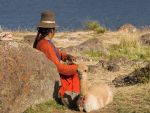Being of Quechua heritage, the revelation that Peruvian Quechua pastoralists essentially work for free for luxury fashion brand Loro Piana, is enraging. The Bloomberg exposé highlights economic burdens placed on Indigenous communities tasked with producing prized vicuña wool marketed to an affluent clientele. In addition to the exploitative economic practices, it’s equally imperative to add to the conversation about the various Indigenous Andean customs and history that are being infringed upon to understand the true magnitude of this exploitation. Andean way of life encompasses far more than being a small part of a corporation’s fashion supply chain – which often gets overlooked and is crucial to contextualize given their enduring resistance to exploitation by corporations and governments.
Beyond their adorable fluffy exterior, camelids are integral to Indigenous Andean economic, social, political, subsistence, and ritual life. Pre-colonial communities bred and domesticated llamas from wild guanacos for transporting cargo through trade routes and supplying meat. Domesticated alpacas were bred from vincuñas, providing soft wool garments, textiles, and meat for subsistence and market trade. Additionally, they are honored in ritual ceremonies such as llama burials under newly constructed homes, to ensure herd/crop fertility and protection – a practice my own father carried over to our family’s city dwellings. As wild animals, vicuñas and guanacos are considered sacred and should never be owned, symbolizing their connection to Pacha Mama (Mother Earth) and the belief that killing or harming them would bring severe misfortune.
Incans prohibited killing and wearing vicuña fleece, except for royalty, where wool was garnered from 3-day cooperative ceremonies called Chakus, which occurred every four years. These ceremonies involved rounding up, shearing, and releasing vicuñas back into the wild within the same day. The day before a Chaku permission is obtained from Pacha Mama and the Apus (mountain deities), a Pagapu is performed through special offerings, gratitude, and requests for prosperity. However, vicuñas’ reverence diminished during the Spanish conquest, leading to excessive hunting and near-extinction. In 1964, Andean governments reinstated Indigenous laws to restore the vicuña population but then opened a wool export market. Governments later assisted corporations like Loro Piana in purchasing and fencing property along with privatizing wool rights.
The Bloomberg investigation mentions Loro Piana’s application, which asserts that fences could boost vicuña reproduction by up to 50% annually, despite genetic diversity loss and shorter lifespans. Loro Piana’s application fails to acknowledge that infectious diseases and parasites often cause these problems for captive vicuñas. This poses an increased risk of transmission to other pastoral animals, endangering the overall food supply and wool production for Indigenous livelihoods. Native Andean communities have historically opposed permanent fencing, citing these risks plus the limitations to their herd’s open pasture grazing rotation.

Loro Piana’s land ownership practices also raise ethical concerns. Ayni (interconnectivity and reciprocity) is a core tenet of Andean cosmology that maintains ecological balance, rituals, and family organization within the intricate social units called Ayllus. In Allyus, camelids play a vital role in inheritance, land rights, and wealth distribution, such as through hair-cutting ceremonies when children are gifted their first female alpaca/llama from their godparents to build their herd. Contrary to Western norms, Andean Indigenous communities do not approach land tenure through individual and privatized ownership. Instead, communal systems of mutual obligation, accompanied by barter and money market economies, support pastoral maintenance and subsistence in the Ayllu. Commercialization and centralized state administrations often disregard these traditional methods, fragmenting Ayllu collectivism and autonomy.
LVMH’s, the parent company of Loro Piana, land privatization and labor exploitation resemble former colonial encomienda systems (Mita) that required forced labor taxes for the Spanish crown. Years after, this morphed into the hacienda system, where abused Indigenous Andeans like my grandfather were subjected to indentured servitude and perpetual debt (Ponguaje) to Spanish landlords (Hacendados) who privatized estates on Ayllu lands. This system persisted in Peru until the 1969 Agrarian Reform law, spurred by Indigenous political activism and unionization. The fight for Indigenous rights and land recovery continues today, with governments and corporations imposing vestiges of colonial control.
Vicuña was once woven and worn by Incan royalty. Therefore, corporations like Loro Piana, which benefit from vicuña fiber, have an economic and cultural responsibility to restore necessary technology to Indigenous shearers to preserve this ancestral knowledge encompassing science, art, history, politics, and technology. What Loro Piana is doing isn’t ethical and sustainable. It’s multi-billion dollar companies continuing to profit by mining Indigenous communities’ expertise and selling it as “quiet luxury” with a lofty price tag. Indigenous communities have similarly practiced these design elements for centuries, yet they’re often relegated to the label of “artisans” or “craftspeople” rather than being respected as opulent designers, innovators, or creatives who deserve to be paid for their labor and have their rights and livelihoods honored. That’s why as consumers and trendsetters, it’s vital that we question Loro Piana’s financial accountability towards the Andean Indigenous community.




